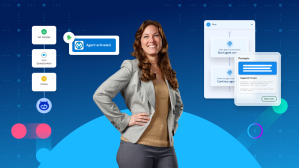Editor’s Note: This story was updated in September 2023 to keep it fresh.
Recently-expanded research shows that The AI Economist — Salesforce’s open source framework for economic policy design — can design more effective tax policies than traditional economic methods.
The research also shows that the framework can use AI simulations to analyze and show a detailed view of the impact a particular policy will have on society.
The research was published in Science Advances, a selective, peer-reviewed interdisciplinary scientific journal, and was done together with the Harvard EconCS lab.
Taxes are an important government tool to improve equality. However, it’s challenging for governments to design tax structures that help create equality while also driving economic productivity.
Salesforce’s latest findings show that AI can help — designing and informing government agencies on tax policies that can improve economic equality and productivity at the same time.
In-depth:
- Salesforce’s expanded research shows that AI can widely improve the trade off between income equality (how similar people’s incomes are) and productivity (sum of all incomes), when compared to three alternate scenarios: a prominent tax formula developed by Emmanuel Saez, progressive taxes, and the free market (no taxes).
- AI can optimize policies for different objectives. This research gives evidence for two objectives: higher equality and productivity for the overall economy, and higher utility (level of happiness for individuals).
- In a simplified economic setting, the AI recovers optimal policies that were previously found using mathematical analysis, helping build trust in the framework.
Fast facts:
- The AI Economist framework designs tax policies using “two-level deep reinforcement learning” (RL). This simulates an economy with people and policymakers whose behaviors are each modeled using AI agents.
- The framework also analyzes how people’s behavior may affect other people and how this impacts which policy is most effective.
- For example, interactions between people strongly affect which tax policy is best. A consumer may buy less if taxes are high, and this can affect the profit of sellers.
- These effects are hard to model with traditional economics, which often assume that people don’t communicate or cooperate strategically. AI provides a more realistic representation of the world.
Zoom out: AI provides a powerful platform for economic analysis and design — far beyond traditional economics, in fact. However, economists have yet to adopt AI techniques more broadly. This research from Salesforce aims to help inspire both researchers and policymakers to adopt and responsibly deploy AI for social good.
Explore further: Read this research paper and blog post to learn more. Read past Newsroom stories on the AI Economist here (The AI Economist: Why Salesforce Researchers are Applying Machine Learning to Economics) and here (Salesforce’s The AI Economist Recognized in World Changing Ideas Competition).
More information:
- Learn more about Salesforce AI solutions
- Find all the news from Dreamforce 2023
Go here for Salesforce AI media resources















